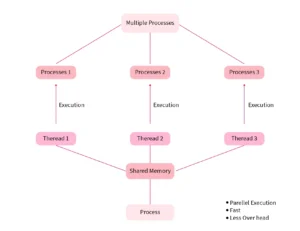POSIX Threads (Optional for Advanced Learners)
POSIX Threads, commonly known as Pthreads, form the standard for threading on UNIX-based systems, including Linux and macOS. The term “POSIX” stands for Portable Operating System Interface, which defines a consistent API for creating and managing threads and concurrency across various platforms.
Although often used in system-level and performance-critical applications, understanding Pthreads gives advanced learners a deeper appreciation of how threading works under the hood.
What Are POSIX Threads?
POSIX Threads are a low-level threading API specified by the POSIX.1c standard. It provides a standardized way for programs written in C/C++ to:
- Create and terminate threads
- Synchronize threads using mutexes and condition variables
- Control thread behavior such as scheduling and stack size
Pthreads are implemented at the kernel level in most systems, allowing for true parallelism across CPU cores.
Key Features of Pthreads
- Thread Creation and Control
Using thepthread_create()function, programmers can spawn new threads that run concurrently. Each thread can be joined later usingpthread_join()to wait for completion.
- Shared Memory Access
Threads within the same process share memory, making Pthreads ideal for applications needing fast and direct inter-thread communication.
- Synchronization Tools
Pthreads offers synchronization primitives like:-
Mutexes: For locking shared resources
-
Condition variables: For coordinating thread execution based on certain conditions
-
Barriers and spinlocks (optional, system-dependent)
-
- Custom Thread Attributes
Developers can control thread attributes such as: -
-
Detachment state (joinable or detached)
-
Stack size
-
Scheduling policy and priority
-
Use Cases for Pthreads
- High-performance computing (HPC) applications needing tight control over threads.
- Operating system components like device drivers or system utilities.
- Embedded systems where lightweight thread control is critical.
- Network servers managing many client connections efficiently.
Benefits
- High performance and fine-grained control over threading.
- Portability across UNIX-based systems.
- Mature and stable—used in many core system applications.
Challenges
- Steep learning curve: Requires detailed understanding of memory management and synchronization.
- Easy to make mistakes: Without careful coding, can lead to race conditions, deadlocks, and undefined behavior.
- Not suitable for beginners or applications where safety and simplicity are more important than raw performance.
Summary
POSIX Threads (Pthreads) are a powerful, low-level threading framework used mainly in performance-sensitive and system-level applications on UNIX-like systems. While not required for basic multithreaded programming, understanding Pthreads provides advanced learners with deeper insight into how threading, synchronization, and parallelism are handled at the system level.
